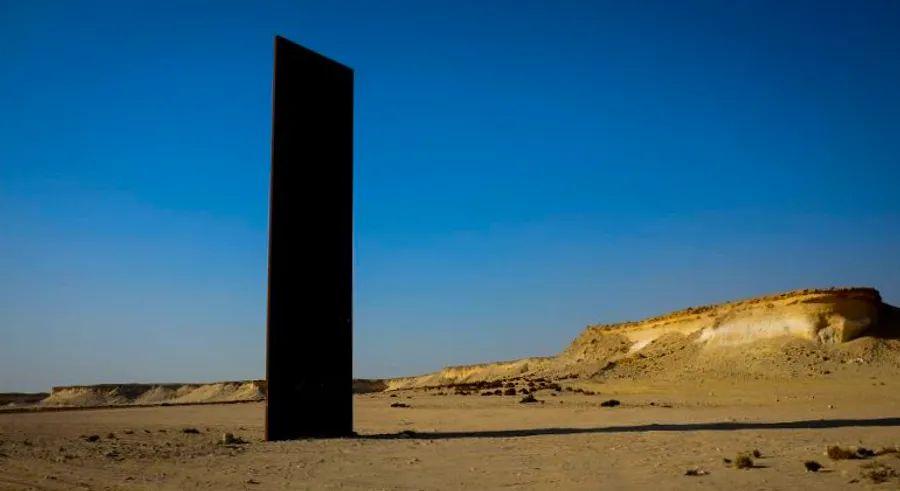The towering monoliths in the desert of Qatar

In the blazing, shimmering sands of western Qatar, something massive, alien, and undeniably strange rises above the horizon.
There seems to be no rhyme or reason behind the sudden appearance of four enormous monoliths stretching across the barren expanse between low limestone cliffs.
Despite their strange presence, these metallic giants have settled into the rugged terrain, adding a majestic touch to this remote part of the small Gulf nation.
Spanning over a kilometer of desert on Qatar's Zekreet Peninsula, these steel sculptures are the work of Richard Serra, an American artist renowned for his monumental metal art installations.
Named "East-West/West-East," these towering landmarks, reaching up to 16.7 meters, were installed in 2014 after Qatar’s art-loving royal family invited Serra to leave his artistic legacy in their country.
Years later, the plates remain as striking as ever. Though weathered by rust and marked with graffiti, their imposing presence remains undiminished.
Remote location

Standing guard over the barren landscape, these monumental figures appear as though they will endure for eternity.
For its creator, the remote location of the artwork, in a place where summer temperatures can exceed 50°C (122°F), was both an inspiration and a cause for concern.
At the time of its installation, he told the Independent, "This is the most fulfilling work I’ve ever created. It’s a piece I truly hope people will experience, though I’m unsure if it ever will."
There was no need for him to worry.
While not overcrowded, "East-West/West-East" has become a semi-frequent destination for locals, tourists, and art enthusiasts, adding to the array of desert activities in Qatar that include dune ing, Bedouin camps, and camel rides.
The journey to reach it is far from straightforward.
The closest major road is over five kilometers away, and there’s no direct route to the sculpture. The desert paths around it are not clearly marked.
Those wishing to visit will need an off-road vehicle, which is not typically available for rent in Qatar for self-driving. Therefore, visitors will either need to have a local contact with a suitable vehicle or book an organized tour. Qatar Inbound Tours comes highly recommended (Souq Waqif, Souq Asiri, Waqif, Doha; +974 5553 1002).
A labyrinth of desert trails.

Unless you're accompanied by someone familiar with the route, a GPS device will be essential. Despite their impressive size, the 'East-West/West-East' sculptures are not visible from the main road. The only indicator is a sign pointing to 'Camel Underpass No. 7.'
From there, it's a matter of navigating through a labyrinth of uneven sand tracks, passing occasional desert camps.
It's not the ideal place for a flat tire or vehicle failure – the area is remote, with few cars in sight, and only lizards and possibly a stray camel for company.
But when the sculptures finally come into view, all the effort is rewarded – especially for fans of the classic sci-fi film '2001: A Space Odyssey.'
Placed 250 meters apart along a straight path, the monoliths rise one after another, each progressively towering over the last, creating an intentional play of perspective.
Up close, they loom incredibly tall, casting massive shadows that stretch further as the afternoon sun races across the sky. Though they’re solid enough to withstand blows quietly, from the side they almost seem nonexistent.
A symbol of resistance

It's difficult to truly grasp the scale of the monoliths unless you're accompanied by others, but the short, rocky five-minute climb up the nearby cliffs offers a spectacular view of the monoliths as they stretch toward the sea.
If the heat isn’t too oppressive, walking the entire kilometer of the sculpture is an experience you shouldn't miss.
Serra’s worry about the sculpture lacking visitors was clearly misplaced, as evidenced by the graffiti that has accumulated on the metal plates over the years. While it's not exactly an enhancement, it has become an undeniable part of the artwork’s evolution.
During a Dinogo visit back in 2014, some graffiti simply marked 'I was here,' but others carried deeper messages—ranging from artistic expression to displays of national pride. Recently, several pieces have echoed defiance in response to regional sanctions.
Not surprisingly, the highest graffiti found on one of the plates appears to be from visitors from Nepal, nestled in the Himalayas.
While the sculpture 'East-West/West-East' offers plenty to marvel at, it’s far from the only attraction on the Zekreet Peninsula.
Desert mushrooms

A short drive further west brings you to the Al Reem Biosphere Reserve, a UNESCO-protected sanctuary that’s said to be home to rare desert wildlife, including gazelles, oryx, and osprey, though spotting them can be quite a challenge.
Inside, you’ll find more local curiosities.
First up is Film City, a small, deserted town in the heart of the desert, with a Qatari flag fluttering from the top of its tallest tower. The gates are usually open, allowing visitors to wander in, explore, and, if they’re fortunate, enjoy a cup of sweet tea with the security guard.
There’s little mystery to this place. Originally built as a film set, it has been used in various Arabic dramas and as a backdrop for promotional material for the 2022 FIFA World Cup in Qatar.
A bit more enigmatic in appearance, though, are Qatar’s “desert mushrooms,” located just a few kilometers further along the peninsula.
Here, centuries of wind erosion have hollowed out a limestone basin, sculpting the rocks into striking, mushroom-shaped formations. A standout feature, known as ‘umbrella rock,’ is a weathered stone island crowned with a building that’s unreachable.
These, along with other small buildings in the hollow, are replicas of traditional structures once used to store dates.
Today, they serve as the final stop on a tour of one of the most unique destinations in the Arabian Gulf.
Or as a stunning backdrop for an evening of camping beneath the stars, sharing tales of the mysterious desert.
Evaluation :
5/5



